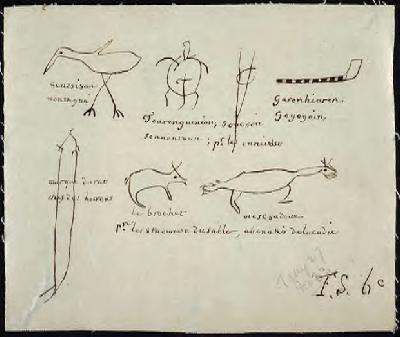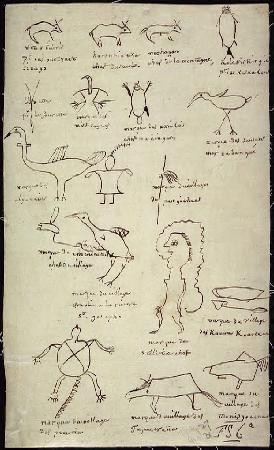|
|
Canku Ota |
|
|
(Many Paths) |
||
|
An Online Newsletter Celebrating Native America |
||
|
August 11, 2001 - Issue 42 |
||
|
|
||
|
The Great Peace of 1701 |
||
|
These totems are taken from the treaty known as the Great Peace of Montreal, signed on August 4, 1701. Each chief signed by drawing the totemic animal of his tribe. |
 August
4, 2001 — Three hundred years ago, the city of Montréal was a small French village on the banks of the St.
Lawrence River called Ville Marie. Its 1,200 citizens -- ranging from noblemen and military officers to merchants
and craftsmen -- witnessed the signing of one of the most remarkable peace treaties in the New World. It was both
a trade and a security agreement between French settlers and the indigenous people -- a mutual understanding that
would last well into the next century. August
4, 2001 — Three hundred years ago, the city of Montréal was a small French village on the banks of the St.
Lawrence River called Ville Marie. Its 1,200 citizens -- ranging from noblemen and military officers to merchants
and craftsmen -- witnessed the signing of one of the most remarkable peace treaties in the New World. It was both
a trade and a security agreement between French settlers and the indigenous people -- a mutual understanding that
would last well into the next century. Along the banks of the Little St. Pierre River, just outside of the town’s wooden stockade, some 1,300 American Indians had arrived and set up camp for this occasion. They came from the farthest reaches of the Maritimes and the Great Lakes region, from what is now New York, Southern Illinois, Ohio, Michigan, and as far north as James Bay.  Among the 39 indigenous nations represented were the Iroquios nations of Mohawk, Oneida, Onondaga, Cayuga and Seneca, as well as the Huron, Ojibwe, Sable Ottowa, Cree, Hochungra, Potawatomi, Mississauga, Kiskakon, Sauk, Amikwa and Mascouten. On August 4, 1701, they witnessed the signing of "Le Grande Paix," or "The Great Peace," a treaty meant to end decades of bloody conflict between the colonizing French and their indigenous allies, as well as their enemy, the Iroquois confederacy. The French were to recognize the independent sovereignty of each signatory nation and that nation was to pledge peace and goodwill in return. The treaty was signed by the French governor, de Callière, and was marked by leaders from 39 indigenous nations. While it didn’t guarantee a future free of conflict, the treaty virtually ended the Amerindian-French wars and set a precedent of negotiation, which lasted well into the 1800's. This summer, the city of Montréal is celebrating the 300th anniversary of the Great Peace treaty with reenactments, exhibits, food and dances of the Amerindians and the early French settlers. |
|
|
|
The Great Peace of 1701 |
|
Great Peace of Montreal-Official Site |
|
|
||
|
|
||
| Canku Ota is a free Newsletter celebrating Native America, its traditions and accomplishments . We do not provide subscriber or visitor names to anyone. Some articles presented in Canku Ota may contain copyright material. We have received appropriate permissions for republishing any articles. Material appearing here is distributed without profit or monetary gain to those who have expressed an interest. This is in accordance with Title 17 U.S.C. section 107. | ||
|
Canku Ota is a copyright © 2000, 2001 of Vicki Lockard and Paul Barry. |
||
|
|
|
|
|
The "Canku Ota - A Newsletter Celebrating Native America" web site and its design is the |
||
|
Copyright © 1999, 2000, 2001 of Paul C. Barry. |
||
|
All Rights Reserved. |
||

